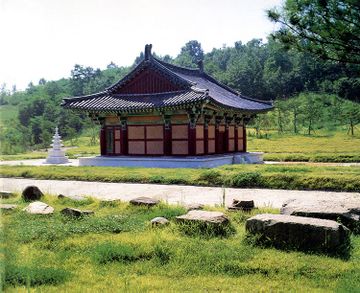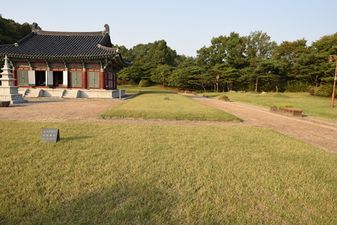청주 흥덕사지
| 청주 흥덕사지 Heungdeoksa Temple Site, Cheongju |
|
| 대표명칭 | 청주 흥덕사지 |
|---|---|
| 영문명칭 | Heungdeoksa Temple Site, Cheongju |
| 한자 | 淸州 興德寺址 |
| 주소 | 충북 청주시 흥덕구 직지대로 713 |
| 지정(등록) 종목 | 사적 제315호 |
| 지정(등록)일 | 1986년 5월 7일 |
| 분류 | 유적건조물/종교신앙/불교/사찰 |
| 시대 | 고려시대 |
| 수량/면적 | 34,337㎡ |
| 웹사이트 | 문화재청 국가문화유산포털 |
|
|
|
목차
해설문
국문
2015
흥덕사터는 1985년 발굴조사 결과 금당터와 강당터, 그리고 탑터와 이들을 둘러싼 회랑터의 일부가 발견되었다.
이와 함께 각종 기와와 전돌, 그릇 조각을 비롯하여, 청동으로 만든 금구(禁口), 작은종, 금강저(金剛杵) 등이 출토되었다.
현재의 모습은 발굴 결과에 의하여 금당과 삼층석탑을 복원한 것이다.
이곳은 현존하는 세계에서 가장 오래된 금속활자 인쇄본 「 백운화상초록불조직지심체요절(白雲和尙抄錄佛祖直指心體要節)」을 간행한 곳이다.
이 책은 1377년(고려 우왕 3)에 백운화상(1298~1374)이 「 불조직지심체요절」을 간추려 엮은 것을 그의 제자들이 금속활자로 인쇄한 것이다.
이 책은 독일 구텐베르크의 「 42행 성서」보다도 78년이나 앞서 인쇄된 것으로, 2001년 9월 4일 유네스코 '세계기록유산'에 등재되었다.
흥덕사터 인근에 청주고인쇄박물관이 건립되어, 인쇄와 관련된 문화의 변천과 발전 과정을 살펴볼 수 있다.
2020
청주 흥덕사지는 9세기 통일신라 때 건립된 것으로 추정되는 흥덕사(興德寺)의 옛터이다. 흥덕사는 현존하는 세계에서 가장 오래된 금속활자본인 『백운화상초록불조직지심체요절(白雲和尙抄錄佛祖直指心體要節)』(이하 『직지』)을 간행한 곳이다.
『직지』는 백운화상(白雲和尙)이 고려 공민왕 21년(1372)에 부처와 고승들의 법어, 대화, 편지 등에서 중요한 내용을 뽑아 엮은 책으로, 우왕 3년(1377)에 흥덕사에서 인쇄하였다. 이는 구텐베르크의 『42행 성서』 간행보다 78년이나 앞선 것으로, 2001년 유네스코 세계기록유산에 올랐다.
1985년 발굴조사 중 ‘흥덕사’라는 글씨가 새겨진 금구*가 나와 이곳이 당시의 흥덕사였음을 확인하였다. 이와 더불어 각종 기와, 전돌, 그릇 조각 등을 비롯하여, 청동으로 만든 작은 종과 금강저** 등의 유물이 출토되었다. 현재는 발굴조사 결과를 토대로 금당과 삼층석탑을 복원하고, 회랑지와 강당지도 주춧돌이 노출되도록 잔디를 심어 정비하였다.
현재 흥덕사지 옆에는 청주고인쇄박물관이 있으며, 맞은편에는 근현대인쇄전시관과 청주시 금속활자 전수교육관이 들어서 있다. 금속활자 인쇄술은 인류 문명 발전의 원동력인 지식 정보의 공유와 확산을 가능하게 한 획기적인 발명이자 우리 조상들의 문화적 위상을 확인할 수 있는 소중한 문화유산이다. 이곳에서는 한국의 인쇄 문화와 금속활자 제작 기술의 발전사를 한눈에 살펴볼 수 있다.
- 금구(禁口): 청동으로 만든 북으로, 공양을 알리거나 사람을 모으는 용도로 사용함.
- 금강저(金剛杵): 승려가 불도를 닦을 때 스는 법구의 하나로, 번뇌를 깨뜨리는 보리심을 상징함.
영문
2015
This is the former site of the historic Heungdeoksa Temple, where Jikji (Anthology of Great Buddhist Priests' Zen Teachings), the world’s oldest book printed with movable metal type, was published.
This book was compiled by the Buddhist monk Baegun in 1372, and was printed by his disciples at the temple in 1377.
This precedes the publication of the Gutenberg Bible by 78 years.
In recognition of its significance, Jikji was registered in the UNESCO Memory of the World in 2001.
The exact location of Heungdeoksa Temple had been unknown until 1985, when researchers found a bronze gong bearing an inscription of the temple's name during an excavation survey here.
Other excavated artifacts include various tiles, bricks, miniature bronze bells, and a Buddhist ritual scepter.
In accordance with this excavation survey, a prayer hall and a three-story stone pagoda have been reproduced on the site.
The Cheongju Early Printing Museum, which shows the history of printing and publishing culture in Korea, was also built at the entrance to this historic temple site.
2020
The Heungdeoksa Temple Site in Cheongju is the place where Heungdeoksa Temple is known to have been located during the Unified Silla period in the 9th century. The temple is where Anthology of Seon Teachings by Great Buddhist Priests Compiled by Buddhist Monk Baegun (abbreviated title: Jikji), the world's oldest remaining book printed using movable metal types, was published.
The Jikji is a book of the dharma talks, conversations, and correspondences of the Buddha and eminent monks compiled by renowned Goryeo monk Baegun (1298-1374) in 1372 and printed at Heungdeoksa Temple in 1377, 78 years before the publication of the Gutenberg Bible (also known as the 42-line Bible). The book was inscribed in the UNESCO's World Heritage (Memory of the World) List in 2001.
The excavation of the site in 1985 resulted in the discovery of an ornamental metal object bearing the inscription of the temple name Heungdeoksa, suggesting that it was the site of the temple. Also found by archaeologists at the site were shards of ceramic tiles, including rooftiles, and pottery as well as small bronze bells and vajra. The excavation was followed by a restoration project through which the temple's main dharma hall was restored together with the three-story stone pagoda. The rest of the remaining features, including the foundation stones of the temple's galleries and lecture hall, were arranged for viewing by visitors.
Within the vicinity of the temple site are the Cheongju Early Printing Museum, Modern Printing Museum, and Cheongju Metal Movable-Type Education Center. The use of metal movable types for printing was an epochal event for the transmission and spread of knowledge and information as the engine for the development of human civilization; for Koreans, such was tangible evidence of the outstanding cultural achievement made by Korean ancestors. Visitors to the temple site are offered an opportunity to have a comprehensive view of the history of topography in Korea and the development of metal movable types.
영문 해설 내용
2015
이곳은 흥덕사의 옛터이다. 흥덕사는 세계에서 가장 오래된 금속활자 인쇄본인 「백운화상초록불조직지심체요절(白雲和尙抄錄佛祖直指心體要節, 직지)」를 간행한 곳이다.
「직지」는 백운화상이 1372년에 간추려 엮었고, 그의 제자들이 1377년에 인쇄하였다. 이는 구텐베르크의 「42행 성서」 간행을 78년이나 앞선 것이다. 이러한 중요성을 인정받아, 「직지」는 2001년 유네스코 세계기록유산에 등재되었다.
흥덕사의 정확한 위치가 파악된 것은 1985년 이곳에서 진행된 발굴조사를 통해 사찰의 이름이 새겨진 금구가 발견된 이후이다. 이와 함께 각종 기와와 전돌, 작은 동종, 금강저 등이 출토되었다. 금당과 삼층석탑은 발굴조사의 결과를 토대로 복원된 것이다.
한국의 인쇄 문화를 보여주는 청주고인쇄박물관이 흥덕사지 입구에 건립되었다.
갤러리
금구에 새겨진 글씨[1]
참고자료
- 청주 흥덕사지(淸州 興德寺址), 문화재청 국가문화유산포털. http://www.heritage.go.kr/heri/cul/culSelectDetail.do?pageNo=1_1_1_1&ccbaCpno=1333303150000#
- 청주흥덕사지(淸州興德寺址), 한국민족문화대백과사전. http://encykorea.aks.ac.kr/Contents/SearchNavi?keyword=%EC%B2%AD%EC%A3%BC%20%ED%9D%A5%EB%8D%95%EC%82%AC%EC%A7%80&ridx=0&tot=784
- 백운화상초록불조직지심체요절(白雲和尙抄錄佛祖直指心體要節), 문화재청 국가문화유산포털. http://www.heritage.go.kr/heri/cul/culSelectDetail.do?VdkVgwKey=12,11320000,31&pageNo=1_1_1_0
- 청주대학교 박물관, 청주흥덕사지 발굴조사보고서, 청주대학교 박물관, 2000.





